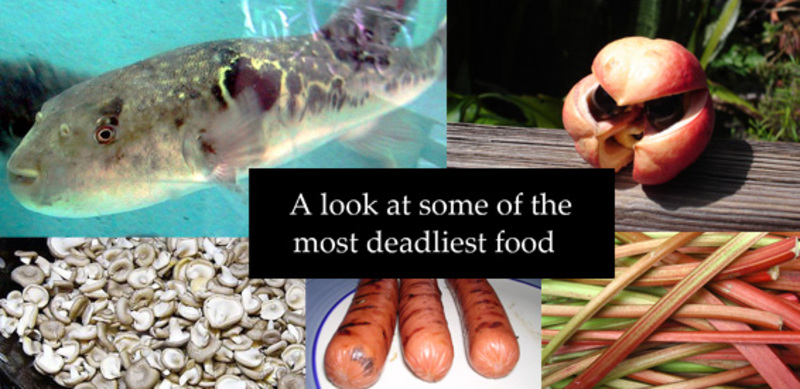By Hollie Bligh
I’m all for something new exciting when it comes to dinner time but risking my life for a dish may be pushing things.
Here is our look at some food that is rather on the deadly side:
1. Fugu Puffer Fish 
Fugu, or blowfish, has been the last meal for quite a few people, even though this wasn’t their original intention. This expensive delicacy is found in Japan and when properly prepared is perfectly safe.
However when the fish is improperly prepared, it will result in death. Fugu contains a tetrodoxin that will cause your muscles to freeze up, and keep a person from breathing. This poison is released when the fish is cut the wrong way and unfortunately, there is no antidote.
2. Giant Bull Frogs
In Namibia one of the nation’s culinary specialities is the giant bull frog. The danger is if the frog selected is too young. These premature bullfrogs that have not yet bred, carry a poison that can cause temporary kidney failure. Provided medical attention is sought death will not ensue, however the person will probably be sick for a fair amount of time after.
 3. Ackee Fruit
3. Ackee Fruit
The Ackee fruit and plant originally from Africa, now also in Jamaica, is an extremely popular fruit, which can be eaten raw, or mixed in with traditional dishes.
The danger comes from the large black seeds inside the fruit which contains the poison hypoglycin, which if consumed, causes severe vomiting, known as "Jamaican vomiting sickness" or "ackee poisoning”. In worse case scenarios it can cause coma or even death.
4. Casu Marzu Cheese
Casu Marzu is perhaps the most dangerous cheese on the planet, in fact the cheese is now illegal to produce, but people in Sardinia eat it anyway. This Italian cheese, which is known as “the rotting cheese,” is left out in the open for days which allows flies to land and lay eggs inside. When the eggs hatch the maggots come out and eat some of the cheese, and the fermentation process is sped along. The problem is that sometimes the maggots survive inside the human body and cause severe health problems, such as bloody diarrhoea and vomiting.
5. Rhubarb
The important thing to remember when cooking with rhubarb is to only use the stem, and never consume the green leaves. Rhubarb leaves are full of oxalates, which are poisonous if ingested in significant amounts, which can cause seizures and severe respiratory problems.
6. Monkey Brains
Served mainly in Asia, monkey brains can be extremely dangerous. There is an illness called Variant Creutzfeldt-Jakob disease, which is similar to Mad Cow disease, that can lurk inside a monkey’s skull. This disease will destroy a person’s brain, and cause death.
 7. Sannakji Choking Octopi
7. Sannakji Choking Octopi
In Korea, Sannakji wriggling octopus is considered a great treat for those who love seafood. The danger is these octopi are served while the animal is still moving. They have been known to attach their tentacles and suction cups around the necks of diners and choke them to death.
8. Hot Dogs
Hot Dogs may not seem that deadly but they can cause asphyxiation, especially in young children, which can lead to death. Small bites should always be taken and for little children Hot Dogs should be cut up before serving.
9. Cassava root
Cassava root is used to make tapioca. If the cassava is improperly prepared, it can produce cyanide. Eating this root is one way to get a healthy dose of carbohydrates, however you have to make sure it’s always properly cultivated and cooked, otherwise you might get some unwanted poison as well.
10. Mushrooms 
The danger with mushrooms is when people head out into the forest and pick their own, the results being deadly if they choose the wrong kind. Poisonous mushrooms, often referred to as “toadstools,” carry toxins that can make a human very sick, and even result in death.




















There are no comments yet.
You could be commenting on this if you had an account! Click here to sign up.